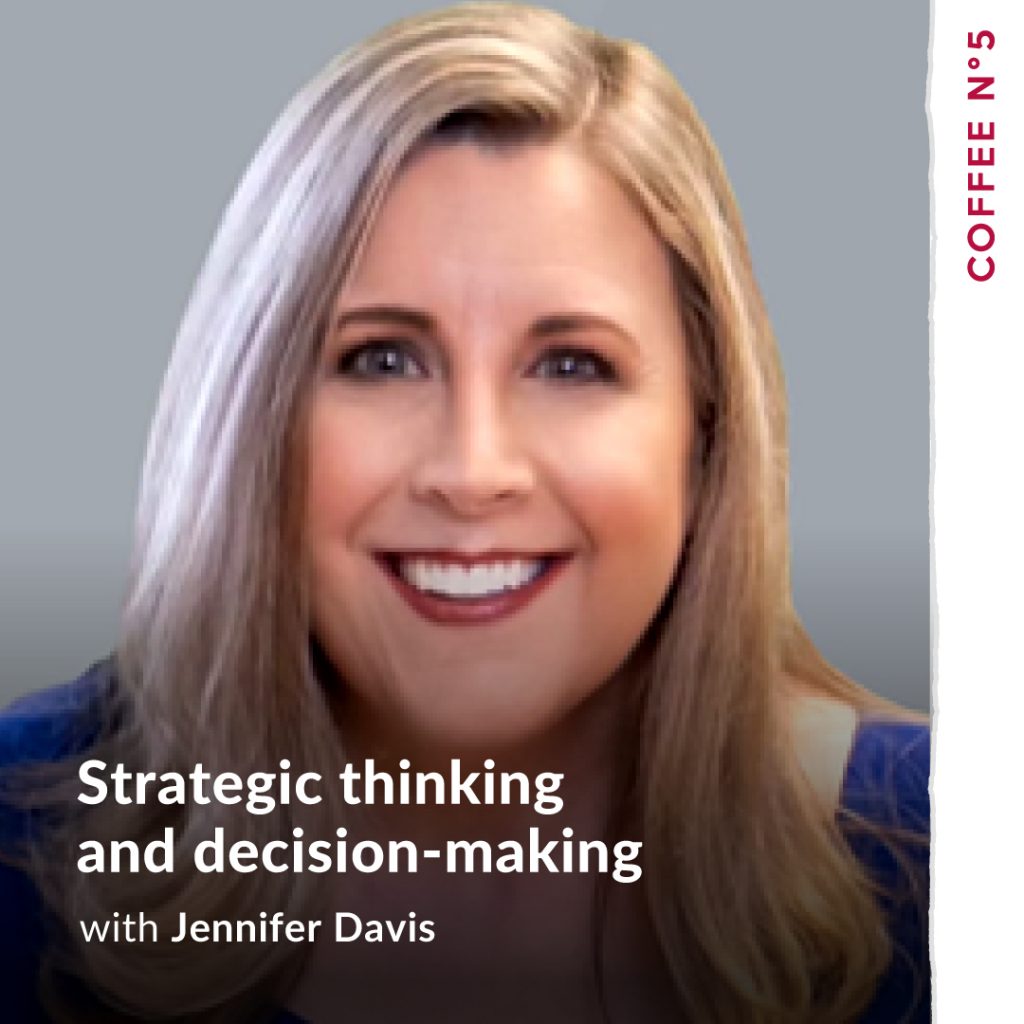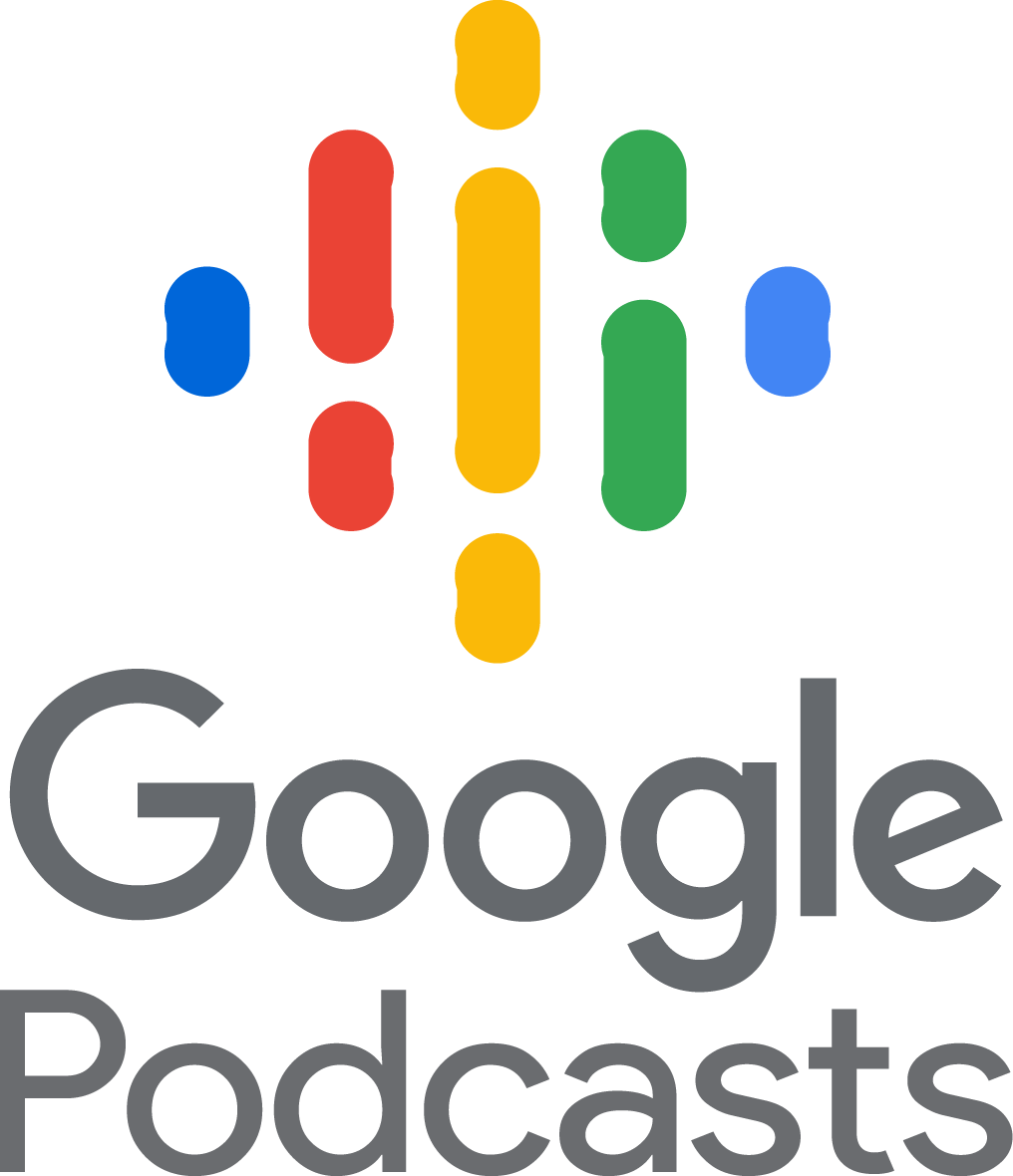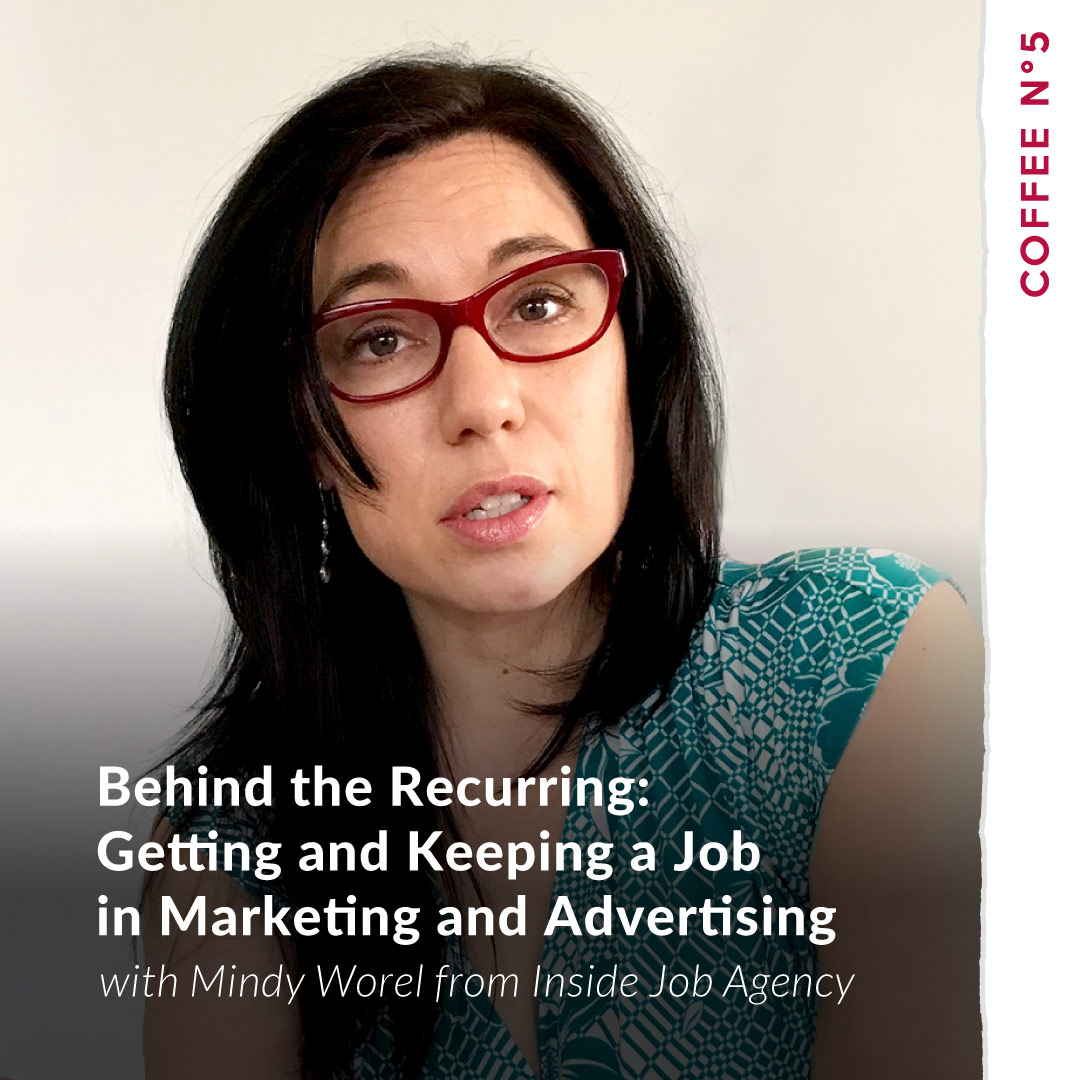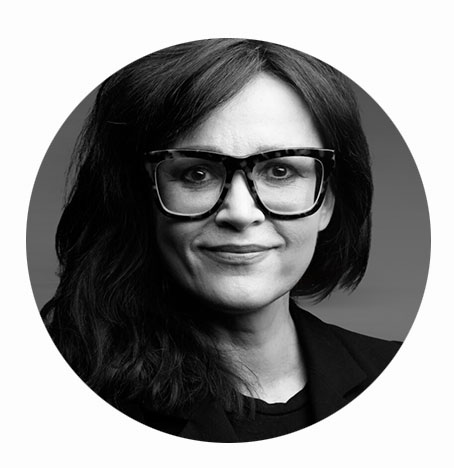Episode 68 – Coffee N.5 – Strategic Thinking and Decision-making with Jennifer Davis
Lara Schmoisman 0:05
This is Coffee N5. I’m your host, Lara Schmoisman. Hi, everyone. And welcome back to Coffee N5. Sometimes it’s all about making decisions. And being a business owner, being a leader is about making decisions, but also taking risks. As a business, like I always say, you are risk management, you’re always evaluating your risk management in your business, if I spend money in this I do I have money to spend in this. If I take this client, do I have the team or I need to hire more? If I hire these people, will I be able to work well with the team? There are so many factors or ingredients in this mixing that we do every day. And a big factor also of making decisions is not making rash decisions for me is always as I say, you need to re-create a sustainable growth, but at the same time, create a cohesive growth. And sometimes that doesn’t happen. And when you start a business, it just grows. Thanks, God. But sometimes it gets messy. And you need to restructure, you need to learn from what works and what doesn’t work. And, that happened to me. This week, I had to make a tough call. It was tough. I’ve been working on this for, I would say six months. And the last three months, I knew that it was inevitable. it had to be done. I had to process it. And I had to deal with it emotionally too because it’s your baby, your business is your baby. But the numbers don’t lie, the facts don’t lie. So when you have to make tough decisions, you need to have a plan, and a plan that you’ll be able to execute and sustain. Today, I invited someone that I met through a colleague , Jennifer Davis. She has written a book about very similar situations. And welcome, Jennifer, thank you so much for being here at Coffee N5. And I want yourself to tell us about who you are, why you wrote this book. And tell us a little more about what the Book is about?
Jennifer Davis 2:38
Sure. Absolutely. Well, thank you so much for having me. It’s an honor and a privilege to be here. My name is Jennifer Davis, I am the Chief Marketing Officer for a company called Learfield, VR technology and data and media leader in the collegiate sports space and live entertainment. And we have relationships with schools all over the country and bring fans and brands together in really innovative ways. It’s a fun, fun space to be in. But one of the things that I had been wanting to do for quite a while and really took the opportunity over that pandemic was writing a book. And so I just published a book called well made decisions this past August. And the book is about the impact and the techniques that people can use to not only make right decisions, but make those decisions, right. I find that in a business context decisions, much like inspiration or genius, is 1% inspiration and 99% perspiration. And so it’s really about finding that balance that you talked about in your introduction between thoughtfully weighing choices, getting input, doing analysis and research and needing to make high velocity decisions to take advantage of growth opportunities in your business. And how do you balance those? So that’s what the book is about.
Lara Schmoisman 4:10
Can we break it up a little Jennifer, thank you so much, again for being here. Because I love that everyone says I’m creative. And we need something new to create this company. But yeah, every company needs to offer a unique value. But at the same time, I still run the business. And I think that there is a marketing that you do as a business but also you need to to deal with your company and the functioning of your company as your own business as a marketing plan itself.
Jennifer Davis 4:49
Sure, sure. I think one of the questions that I get asked a lot is how to market marketing within the organization. And I think you’re totally right, especially When you rise to a level of a leader where you’re not just an emotional leader, you might be over multiple functions in your organization, operating either as an owner operator or as a member of an executive team, your responsibilities are broader than any one function. And so you need to think about the whole organism. And how it operates. I think that’s a point of view that helps you to determine the kind of decisions that you’re making, and how to differentiate your business.
Lara Schmoisman 5:34
I like when you explain all this, your last point was how to grow. And I liked that it was the last point, because before growing, you need to experience a lot of other things you need to establish as a company.
Jennifer Davis 5:53
So yeah, I think it’s interesting, because growth is the result. Growth is the result of having many things that deep empathy, or a customer group understanding of need, bringing forward a solution to that need, hopefully, that’s differentiated in the marketplace and has good value. It’s being able to implement and, you know, fulfill that need, make promises and keep them and do it in such a way that you can retain and attract the talent required to grow that business. So yeah, there’s a lot of work streams, working in concert in order to deliver growth. And, again, that doesn’t mean that growth doesn’t come right away. You know, if you’re a startup, you’re kind of counting on some things breaking your way early to be early indications of success. But long true growth is the result of doing a lot of things right, Every day.
Lara Schmoisman 6:58
I got to turn this around a little because I want to talk about that from the point of view of a small company, or when they’re looking into marketing, or they’re looking into getting help from marketing. And I feel like first of all, there’s a huge confusion. I know that there are some gray areas, and mostly now with the E commerce platform, but marketing is not sales, marketing supports sales. They should be a sales strategy anyway,
Jennifer Davis 7:30
you might use it again, I think it goes back to the business strategy. What do you win? Well, I once had a great CEO, who would often ask the question, why do we deserve to win. And I actually like that language, because it forces you to say, actually, our solution has to be better, our understanding of the need is deeper. Our value proposition is stronger, in some respects, you have an audience, that you’re aiming at a problem that the audience has, and the solution to that. And with that, then you can go to market in a number of different ways. Often that relationship between sales and marketing, or even the ratio of sales and marketing in the sales pipeline, often depends on the kind of business it is. Absolutely, if you’re trying, if you’re a marketer, trying to drive subscribers to an online streaming platform, you may not even have sales, it may be all a marketing driven funnel, you on the flip side, if you work in a b2b company, you may have a very sales driven process. And in that regard, marketing is providing sales, sales, support, sales enablement, maybe providing some communication kind of air cover style communications. So again, I’ve seen it, I’ve seen it drawn many different ways. But ultimately, the organization that you draw, and how sales and marketing, you know, work together or to support that really is down to going back to that business strategy and the problem that you’re solving for a customer.
Lara Schmoisman 9:17
And also, you need to remember that you need to find your customer, the customer is not going to come to you; mostly if you’re a new business, you need to go after them. So if you need to find out first who they are and many times I mean, this is always trial and error.
Jennifer Davis 9:38
Right. Yeah, it’s very interesting. There, if you take an approach that says, the purpose of our organization, long term is to satisfy customer needs in a unique way, all the things I just talked about, but in the short term, our objective is to learn how to do that as fast as possible.
Lara Schmoisman 10:04
Exactly. And you need to be open minded, you cannot say, hey, all my, my clients are millennials, and then you find out that they’re not within your product. So you need to be open to, hey, maybe my client is not here. And I’ve found that I’m totally an omni channel, passionate and passionate. And I think that you need to be whatever your customer is, of course, there are certain things like TV ads are very expensive, and they are not possible for everyone. But you need to analyze first, where your audience is, who your audience is, and maybe in TV it is a different audience, that the one that is online, but you cannot say my audiences in Instagram media, maybe your audience is not there. And you know, to find that somewhere else,
Jennifer Davis 10:54
actually is a good case in point. We’ve done extensive research here at Learfield, about what constitutes a college sports fan. And there are some products that you can just imagine in your mind are associated with sports marketing, beverages, as you know, sports equipment brands, various things that might be automobiles, financial services are often associated with, you know, sports marketing, but what we have found is that with a deep understanding of who the fan bases, there are a lot of brands coming to college sports marketing, because we can bring them a female decision, you know, household decision maker audience, or we can bring them in audience in a particular DMA, or, you know, with a particular, you know, demographic in a particular city that they want to target. And so, in that case, they’re coming to it not because they had originally thought college sports marketing is for me, but rather, it was a means to reach a particular audience. And I think, you know, all of those are true in our business. And I think it’s true of a lot of the marketing, the things that you would put into a marketing mix. They are secondary to your understanding of who your customers are. Yeah. And
Lara Schmoisman 12:15
I found these many small business owners or startups that they think or, you know, there’s always people whispering in your ear. When you have Yeah, you know, that there’s always people that they know better. And somehow, they seem very consistent and whatever. And they have very strong beliefs, and people just choose to believe in them, and say, okay, and great. There’s great salespeople, by the way, but maybe they’re not great providers, and convince someone that I’m talking all about cases that I heard and I saw, oh I spent 1000 of dollars on Google ads, but I didn’t get any return on investment. And I, I was okay, can you tell me, Was the ad for brand awareness? Was it for selling? How did you measure? And they couldn’t answer any of those questions, because they just put an ad without an intention.
Jennifer Davis 13:21
Right, right. And again, if you focus on it, I’m going to run these ads, because I obviously want results. And I identified ahead of time, what success looks like, and I’m measuring against that. And the whole point in doing that experiment, or test or a variation is to learn to learn.
Lara Schmoisman 13:43
Absolutely. And to get data see who is consuming, consuming those sets, right? And it’s a learning curve. But every time I put out for a new company, they don’t have that persona, identity and what they know where they are already. I say let’s go broad. And then we’re gonna get information about who’s attracted to us. And then we start narrowing until we find who is our persona, but it’s a great way to get information.
Jennifer Davis 14:12
Yeah, oh, absolutely. I think, you know, digital advertising, especially for longtail terms could be an interesting way to, to really root out who cares about your, the need that you’ve identified and the solution that you have
Lara Schmoisman 14:30
So let’s go back because you’re talking about 1% inspiration and 99% perspiration. So the 1% is clear. Let’s talk about the other 99%. What does this word mean?
Jennifer Davis 14:45
Yeah. So it’s basically this idea that a decision that you make, I’m going to go into a new market, I’m going to buy a new company, I’m going to expand into a new product line any risks that you might take with your business that might represent In an investment, I’m going to do a new marketing strategy. That decision is the finish line of a decision making process. But more importantly, it’s the starting line, or the implementation. And that starting line is going to involve a lot more resources, a lot more people’s time, a lot more, you know, financial investment, a lot more time than the decision did. And often we look back, and we’ll say things like, that was a really good decision, opening up into that new market or investing in that new product. And we kind of over credit the decision with the success. And we kind of under credit, the work that went into making that decision, right, all the people who got involved in all the subsequent decisions, even though little pivots along the way lead to the eventual results.
Lara Schmoisman 15:57
But also we need to learn about what is bad for us. I mean, it’s great. I mean, and this is something that I try to exercise with my team all the time. Like when mistakes happen. I bring it as a learning opportunity. Not everyone says that, but for me I set a team learning opportunities, because you learn from other people’s mistakes, you learn more from mistakes, you learn from many times get things right, because the luck factor is always there, too.
Jennifer Davis 16:31
Hopefully, luck is on your side. But abs, absolutely, I think, along the way, you win, you’re gonna win seven, you’re gonna lose some. But if you’re really thoughtful about taking them, you know, you pay the tuition, you guys will get the learning.
Lara Schmoisman 16:49
Absolutely. But I also want to talk about this luck factor. Because, of course, you have to be lucky iin the right time at the right place. Timing is huge in anything you do. I mean, the wrong movie going out of the wrong weekend is going to fail. Sure. So we need to make sure that we always consider that something that we did well as maybe was an ice insulated thing. And it was what we call in marketing an unicorn that we need to see who can repeat it and not always repeat. So we don’t know if we can count that as a truth until we repeat it.
Jennifer Davis 17:35
yeah, absolutely. Just like, I don’t know, doing any scientific or technical development, you want to repeat, have repeated success, or you need to, in order to solve a problem, you need to often be able to replicate the problem. Yes, it’s the same. It’s the same principle. I would also say that teams that have high talent density tend to be a little luckier, teams that really listen to their customer and obsess about the customer tend to be more lucky, teams that are more diverse, so that they’re listening to different inputs and can see around strategic corners, with all the perspectives that come from a more diversity tend to be more lucky. So there’s some things that you can do to put luck on your side.
Lara Schmoisman 18:29
I want to hear more about that. What are the luck factors that we can implement in our business? To make sure it’s successful?
Jennifer Davis 18:39
Sure. Well, I guess I’ll talk about the first one I mentioned: talent density. Really see i in the team at Netflix have written extensively on what happened one time when they were going through an early stage crisis in their business and had to cut staff. And they very well expected when they had to reduce staff, that they wouldn’t be as a team less productive because they have less capacity, like less people in the building. But they found the opposite was true. And it was shocking that it was true. There was a renewed energy to the space and people were actually being more productive and more collaborative. And the lesson that they took away from that is that when you only have high performers, those high performers are not distracted by having to remediate for others or to do the work of others. You also have more efficient meetings, meetings, internal communication, collaboration forums in life, and become more enlivened and productive because you had people that were engaged and engaged Ready to contribute at the highest level. And, you know, he talks about in his book, you know, the new rules Rules, he talks about the idea of, you know, if you want to have talent in a room that could light a light bulb, you know, and, and when you when you have that you have people who are then looking ahead and advocating for the customer and being able to execute quickly and, and that turns into something that you look back and think that was said, that got us the results that we needed.
Lara Schmoisman 20:30
I totally agree with you. I mean, I, as I told you, at the beginning of this conversation, I’m in the process of restructuring my company. And I found out that having high performers at the beginning was kind of a threat, what’s going on here are we, it gets scary for the team. But after a while of having less mistakes, I found that the people are far more confident in the team that they can rely on one another. And that’s to me so important in teamwork that you know, that you can rely on your team
Jennifer Davis 21:10
100%, especially if you’re doing knowledge work, you know, if we were on an assembly line and passing widgets down the line, there’s other mechanisms for that, but we’re passing ideas around, and we, you know, need to collaborate at a higher level. So that trust factor is very important. The other thing that I would say, as you know, keeps coming back to this theme of understanding your customers better and advocating for them. If you want to put yourself in the path of luck, deeply understand your customer and the problems that they’re facing. And you will train your gut to advocate for them on day in and day out. And that is that data or the anecdotes about what your customer or client needs, will make all the difference in you being able to shift to the things that will solve their problem better or advocate against wasteful spending. And another area as you as you started the call, you know, there’s a lot of leadership that, frankly, that’s just resource allocation, and risk management management. And that happens at every level of your company. It’s not just the CEO or the president who does resource allocation. Every single individual contributor, the most junior employee in your company, is allocating their own time and energy toward things and I get the better they understand what’s going to solve the customer need, the better, will all be at allocating those resources. And
Lara Schmoisman 22:40
I think I mean, of course you want I’m a big believer in mentoring and to give my team whatever my experience is. But also I believe that each one in the team needs to be able to contribute to bring an added value. So to me, someone who interviews for my job, a job with my company, and tells me I want to come to your company to learn from me is a bad start. What are you bringing into the company? And I found that in a lot of interviews, and people even put in their resumes, you need to be accountable, what do you have to give?
Jennifer Davis 23:21
I think that is true. I think everybody should know, I’m able to articulate and be self aware enough to know what they bring, why their superpowers are and what they can be relied upon and trusted to deliver. And then everybody should have ideas about areas in which they want to grow and learn, especially things that might round out their experience or deepen their understanding of something. I think that’s good, but there has to be balanced in that to your
Lara Schmoisman 23:51
abs. Absolutely. Before we go, I’m going to ask you the same question that I always asked my guests, which is tell us a mistake you made that we can learn from your mistake.
Jennifer Davis 24:06
Well, one of the mistakes that I highlight in the book and actually is one that closely ties to the conversation that we’ve been having about customer obsession is at the time I worked for a company that made and marketed high end video products for residential use. So we provided the technology that powered home theaters and home cinema. It’s a wonderful business to be in a fun space to play. But we had heard from some of our channel partners that they wanted a product that would enable 3d video playback so 3d movies, and we, myself and others in the product leadership area had a great relationship and partnership. We set about making the best product in that category. And I’m extremely proud of the solution that we came up with. But here’s the problem, we didn’t really understand the problem we were solving as deeply as we should. And we ended up developing a fantastic product that did not have the need in the marketplace that we believed was there. And so the sales results were disappointing, and all the time and energy that we had spent into engineering, this product that delivered comfortable and incredible quality 3d video, amazing experiences was just not what people wanted. And the work that we could have done on the front end, again, I take this on on me, the work that we could have done on the front end, to really vet the requirements to really understand how people were making decisions about video in their home, as that was the space we played in to really understand how they were going to evaluate technologies, what other things existed as alternatives. Those things ended up making all of the difference in the success of the product. So here we had a product that was literally winning awards for how high quality it was, and was disappointing in the marketplace. And that comes down to really deeply understanding the needs of the customer, and being able to align resources to solve that customer need to the best of our ability. And because you can distract yourself by solving problems that don’t need to be solved. And you can really distract yourself by solving them well. When they did, it wasn’t a good use of resources.
Lara Schmoisman 26:49
Thank you for sharing that that was inspiring. And so true. So true that when you have a new product, you’re an entrepreneur or a business owner, you need to find out who’s your customer? And when you find out who their customer is, are you resolving the needs or the problem? How are you fixing that problem. And that’s why people are looking for solutions.
Jennifer Davis 27:14
And they’ll and they’ll remember, not the widget that you brought, or the solution that you brought, or the software the service that you brought forth, they’ll remember that they had a pain that you help them with absolutely you permission not only to go back to them and with your next solution and beyond. But it gives you permission to solve a whole host of other problems.
Lara Schmoisman 27:35
And also because you created trust is the same thing that we were talking about in your business environment that you know what you’re doing and your team knows that they can trust you is the same with the product is building a relationship, a long lasting relationship,
Jennifer Davis 27:54
and that is at the heart of what builds a brand. They’re trusting you to deliver a solution. And you are known for the thing that you help them help them to do and that’s the essence of Brandon,
Lara Schmoisman 28:09
that for me is a successful campaign. Thank you so much, Jennifer, for being here. It was a pleasure talking to you. And we’re gonna give all the information of your amazing book in the chapter notes and episode notes and read the book and share back your picture and read and tag us. So I’ll see you guys next week at Coffee N5. It was so good to have you here today. See you next time. Catch you on the flip side. Ciao ciao.








